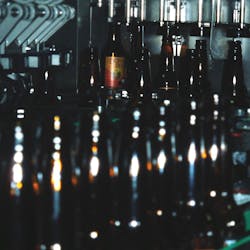Brewery tours, small batches, multiple product lines and fresh beer are terms synonymous with the craft beer industry. Small batches of unique flavor profiles have won over mainstream beer consumers, and now craft beer makers are thinking bigger for their operations.
Among those craft beer makers with plans for growth is Two Brothers Brewing Co. in Warrenville, Ill (www.twobrothersbrewing.com). In its 16th year, the company will produce close to 37,000 barrels of beer.
With 40 percent year-over-year growth in recent years and more expansion plans, Two Brothers installed a new KHS Innofill Micro DPG filling machine in 2013 and now have it running at 250 bottles/min. The company commissioned an entire new packaging line early in 2013 for its 60,000-sq.-ft. production building, which also includes beer processing operations. This monobloc rotary system for craft brewers includes 48 filler and rinser heads, along with a 12-head crowner that can output 300-350 bottles/min.
Brendan McGrath, plant manager for Two Brothers, specified and designed the new filling and packaging line. “We decided now was the right time for a whole new line, especially when we’re moving to more out-of-state markets and really want that quality to be there,” he says.
Out-of-state markets mean longer shipping times. Freshness is vital in the craft beer industry, where unpasteurized beer is the norm.
The centerpiece to the new packaging line is the monobloc filling system with electro-pneumatic controlled filling valves. “The electro-pneumatic allows some programmable variation in the pre-evacuation—oxygen flushing of the bottle—and filling phases. These steps are something craft brewers emphasize since they are running different types of beers with different CO2 flow characteristics and different fill temperatures,” says Bob Pease, director of Wet End Group Products, KHS USA (www.khs.com), who worked with Two Brothers on the installation.
The bottles are evacuated and injected twice with CO2 before filling at Two Brothers, with the first round of O2 evacuation/CO2 injection removing 90 percent of the oxygen from the bottle and the second round eliminating another 9.9 percent of oxygen.
Electro-pneumatic technology has been used by major brewers in larger head sizes, such as a 96-head fillers and rinsers, for some time. “The objective was to downscale the electro-pneumatic technology in a way that maintained our charter of robust machine design and offered the same caliber of filling systems used by major breweries, but at craft beer price points,” Pease says.
Control for the filling machine is done with a Rockwell Automation (www.rockwellautomation.com) CompactLogix PLC RSLogix 5000, which runs the motion on the machine, such as the carousel, infeed star wheels and crowner (capper).
With this electro-pneumatic design, the filler is able to reduce the number of control platforms on the machine through electronic control of the pneumatic filling valves from the PLC, eliminating the need for separate industrial PC controls next to the valves. The sophisticated control offers a larger range of machine speed because of servo drives being used with the carousel, infeed stars and crowner.
The filler’s machine design also eliminates many mechanical components, such as drive trains, couplings, shafts and gears, while creating a more streamlined and hygienic filling system, according to KHS.
Green beer
Two Brothers is known for its environmental stewardship in the Chicago area, with its farm-to-table brewhouse restaurants, recycled process waste for biofuel, and the use of recycled can carriers for its multiple beer lines in 12 oz. aluminum cans.
With this spirit in mind, McGrath and Two Brothers decided to create a water-saving feature for the high-volume, glass-bottle filling machine. Newly labeled bottles travel along the infeed conveyor to the monobloc filling system, where a 48-head rotary rinser picks empty bottles and arranges them in a horizontal position. That’s where an injection of water rinses the bottle and then inverts the bottles to remove excess water.
The unique machine design catches all excess rinse water with metal collection tables positioned underneath the 48-head rinser. The water is then pumped about 10 ft to the post-filling area, where newly crowned bottles receive a quick rinse before moving to an accumulation area. “This is a unique feature of the filling machine, and we are always looking at ways to be more efficient in the production and packaging process,” McGrath adds.
Faster changeovers in the mix
The control platform for the filler also aids in quicker changeovers, where 12 oz, 22 oz and 375 mL bottles move in and out of the packaging line at Two Brothers. “For the filler, we adjust star wheels and guides for bottle sizes and height manually,” McGrath says. “However, the rest is automated and all control work is done via recipes in the HMI. It raises and lowers filling valves to their set points, say for a 22 oz bottle, and this reduces our changeover time by a great deal.” The HMI for the filling system is an Allen Bradley PanelView 700.
Other new equipment for the packaging line includes a 15-head pressure/sensitive labeler from Italian-based PE Labellers (www.pelabellers.com), and 17 Baldor/Reliance (www.baldor.com) electric motors that power the conveyor lines.
About the Author
Grant Gerke
Digital Managing Editor

Leaders relevant to this article:
